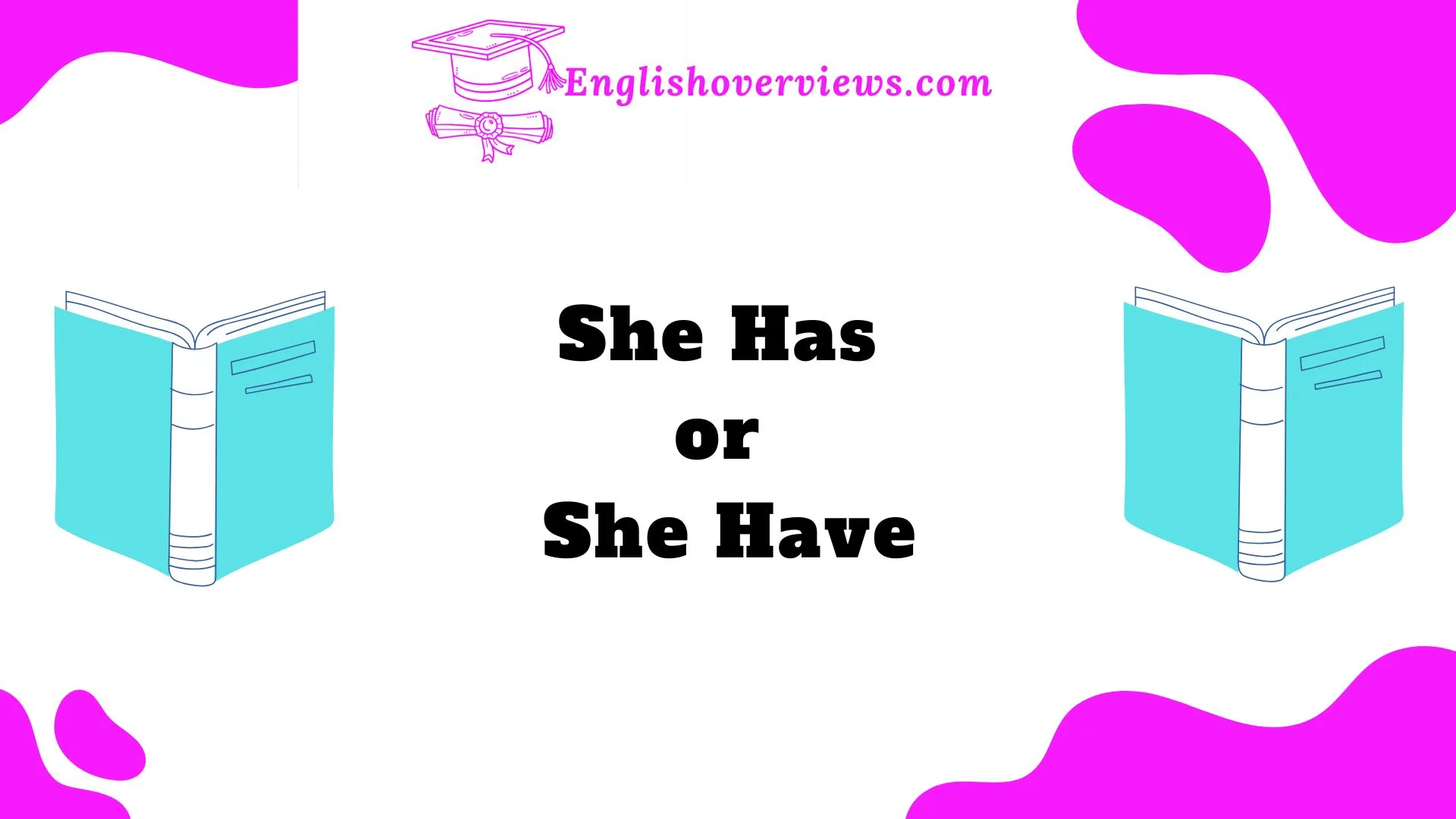When you’re speaking or writing in English, one of the most important rules you need to follow is subject-verb agreement. This rule ensures your sentences sound natural and grammatically correct. One of the most common points of confusion is whether to use “she has” or “she have.”
Although it may seem like a minor detail, choosing the right form can make a big difference in how your message comes across.
In this article, we’ll break down the proper usage of “has” and “have” to help you avoid common mistakes and master subject-verb agreement. Whether you’re a learner or a seasoned English speaker, you’ll walk away with a clearer understanding of when to use these verbs. So, let’s dive into the details!
Understanding the Basics: “Has” vs. “Have”
What Are “Has” and “Have”?
Both “has” and “have” are forms of the verb “to have,” which means “to possess” or “to hold.” The main difference between the two lies in their subject and tense agreement.
- “Has” is used with third-person singular subjects, like he, she, and it.
- “Have” is used with I, you, we, and they (plural subjects).
Quick Overview of Subject-Verb Agreement
Subject-verb agreement is a grammatical rule that states the subject and verb must match in number and person. This means:
- Singular subjects require singular verbs.
- Plural subjects require plural verbs.
Examples:
- She has a new book. (singular subject)
- They have a new book. (plural subject)
Understanding this rule makes it easier to decide when to use “has” and when to use “have.”
The Role of Subject-Verb Agreement
Basic Rule: Ensuring the Subject and Verb Agree in Number
At the heart of subject-verb agreement is the idea that singular subjects require singular verbs and plural subjects require plural verbs. Let’s take a closer look:
- Singular: “She has a cat.”
- Plural: “They have a cat.”
In these examples, the subject (“she”) is singular, so we use “has.” Similarly, for the plural subject “they,” we use “have.”
Key Tip: If your subject is third-person singular (she, he, it), you’ll use “has.” For all other subjects, you’ll use “have.”
Singular vs. Plural: How Subject Type Determines Verb Choice
When deciding between “has” or “have,” remember the basic distinction between singular and plural subjects.
Singular Subjects:
- He has a pencil.
- She has a dog.
- It has a tail.
Plural Subjects:
- We have a meeting.
- They have finished their homework.
- You have a question.
Examples of Common Mistakes
Many learners mistakenly say “she have” or “he have” because they confuse the verb form. Here’s a quick way to remember: Use “has” for third-person singular subjects, and “have” for everything else.
The Third-Person Singular Conundrum
What Is the Third-Person Singular?
In English, the third-person singular refers to he, she, or it—in other words, one person or thing. In these cases, we always use “has” rather than “have.”
Example:
- Correct: She has a new phone.
- Incorrect: She have a new phone.
Why “She Have” Is Incorrect
The phrase “she have” is grammatically incorrect because “she” is a singular subject, and we need the singular form of the verb, which is “has.”
Example:
- Correct: She has a dog.
- Incorrect: She have a dog.
Quick Tip
If you’re unsure whether to use “has” or “have”, ask yourself: Is the subject singular and third-person (she, he, or it)? If yes, use “has.” If the subject is plural or first-person/second-person (we, you, they, or I), use “have.”
When to Use “Has” in a Sentence
Subject: Third-Person Singular
Remember, “has” is used with third-person singular subjects like she, he, and it. Here are some examples:
- She has a great idea.
- He has finished his work.
- It has been a long day.
Negative Forms of “Has”
To create a negative form of “has,” we use “has not” or the contracted form “hasn’t.”
Examples:
- She has not completed the task.
- He hasn’t arrived yet.
Questions with “Has”
In questions, we invert the subject and verb. For third-person singular subjects, we always use “has.”
Example:
- Has she seen the movie?
- Has he spoken to her?
Exploring Examples with Third-Person Pronouns
Let’s look at more examples of how “has” is used with third-person pronouns like she, he, and it:
- She has a meeting this afternoon.
- He has a great sense of humor.
- It has rained all day.
These sentences show how “has” works with singular third-person subjects. Remember, if the subject is singular, you’ll use “has”.
Common Mistakes
Many people say “she have” or “he have” because they mistakenly think “have” can be used with singular subjects. Always remember: third-person singular subjects use “has.”
Expressions and Idioms Incorporating “Has”
Common Phrases
Here are some common idioms and expressions that use “has”:
- She has a point – This means she makes a valid argument.
- She has a knack for – This means she’s really good at something.
- He has what it takes – This means he has the qualities necessary for success.
These idiomatic phrases are good reminders that “has” is frequently used with third-person subjects, even in more complex structures.
How These Affect Usage
In certain cases, “has” doesn’t just indicate possession. It’s used to form various idiomatic expressions, and understanding these can help you sound more natural when speaking English.
Common Usage of “Have” Across Subjects
“Have” in Plural Subjects
We use “have” with plural subjects, as well as with “I” and “you” (both singular and plural).
Examples:
- We have a lot of work to do.
- You have a great smile.
- They have finished the assignment.
Correcting Errors
It’s easy to confuse “has” and “have.” If you find yourself saying “she have” or “I has,” it’s time to correct it. Just remember, “has” is for third-person singular, and “have” is for all others.
Situations Calling for “Has” or “Have”
Looking at Subject-Verb Agreement in Context
Let’s compare more complex sentences to see how “has” and “have” work together:
- She has visited many countries. (Third-person singular)
- They have traveled to many places. (Plural subject)
The main difference lies in whether the subject is singular or plural, and how the verb must align with it.
Practice Examples
- She has worked here for years.
- You have been a great help today.
- They have made significant progress.
Quick Recap
- “Has”: Third-person singular (she, he, it).
- “Have”: Plural subjects, and for “I” and “you.”
Considering Collective Nouns and Teams
The Debate Over Collective Nouns
Collective nouns can be tricky. Do we say “The team has” or “The team have”? In American English, collective nouns are treated as singular, so we use “has.”
Example:
- The team has won the match. (Correct)
- The team have won the match. (Incorrect in American English)
Using “Has” for Singular Collective Nouns
If you refer to a group as a singular entity, use “has”.
Example: “The committee has made its decision.”
Addressing Names and Proper Nouns
Using “Has” and “Have” with Names
When referring to people or groups by name, the verb still depends on whether the subject is singular or plural.
- John has finished the project.
- The Smiths have gone on vacation.
In the first example, John is singular, so we use “has.” In the second, The Smiths is plural, so we use “have.”
Navigating Through Perfect Tenses with “Has” and “Have”
Present Perfect Tense
We use “has” for third-person singular subjects in the present perfect tense:
- She has finished her homework.
- He has read the book.
Past Perfect and Future Perfect
The same rule applies in past perfect and future perfect tenses.
Examples:
- She had completed the task by noon.
- They will have finished by the time we arrive.
“She Should Have” vs. “She Should Has”: Modal Verbs and Exceptions
What Are Modal Verbs?
Modal verbs like “should,” “could,” “would,” and “might” always use “have” in their perfect form, regardless of the subject.
- Correct: She should have gone earlier.
- Incorrect: She should has gone earlier.
Why We Use “Have” After Modals
Modal verbs don’t change with the subject. Therefore, “have” is always used after them, even with third-person subjects like “she.”
FAQs
1. Why is it “she has” and not “she have”?
“She has” is correct because “has” is used with third-person singular subjects (she, he, it).
2. Can I say “they has”?
No, “has” is used only with third-person singular subjects. For plural subjects, like “they,” the correct verb form is “have.”
3. How can I avoid mistakes with “has” and “have”?
To avoid mistakes, always remember: use “has” with third-person singular subjects (she, he, it), and use “have” with plural subjects and first- and second-person singular subjects (I, you, we, they).

Alyan Ashraf is the creative mind behind English Overviews, a platform dedicated to helping learners master the English language. Passionate about education and language development, Alyan specializes in simplifying complex English concepts, making learning accessible for students of all levels.











